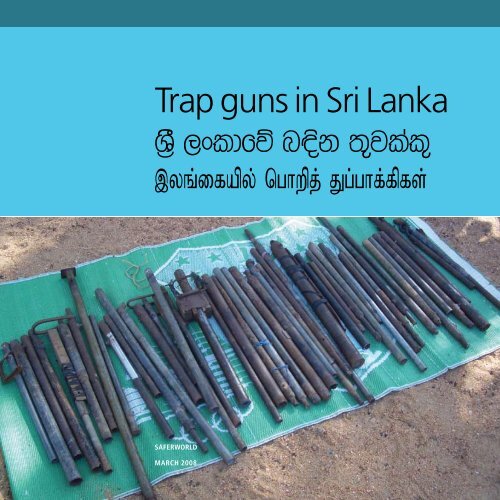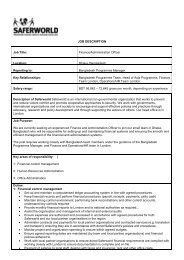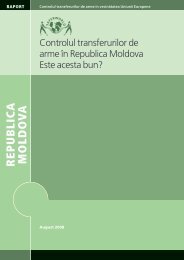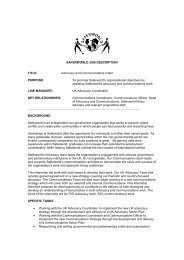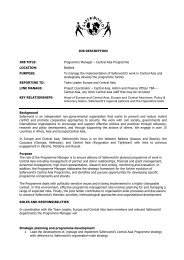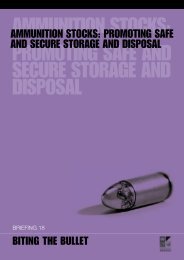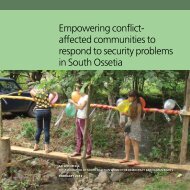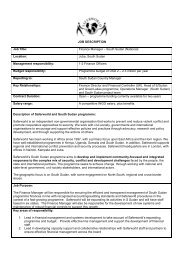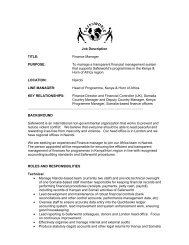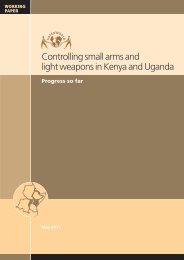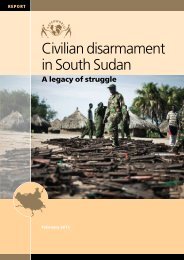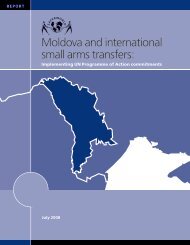English report pdf 2 MB - Saferworld
English report pdf 2 MB - Saferworld
English report pdf 2 MB - Saferworld
- No tags were found...
You also want an ePaper? Increase the reach of your titles
YUMPU automatically turns print PDFs into web optimized ePapers that Google loves.
Trap guns in Sri LankaSAFERWORLDmarch 2008
AcknowledgementsThis paper was written by Nic Benton and edited by Sonia Rai. It presents information gatheredduring the filming of a documentary entitled The Trap, directed by Prasanna Ratnayake. The film andthe gathering of information for this paper were facilitated by South Asia Small Arms Network –Sri Lanka. <strong>Saferworld</strong> wishes to thank those who provided information or participated in interviews.This paper and the accompanying documentary were made possible through the generous supportof the UK Government through its global conflict prevention pool.cover photo: Collection of trap guns from Horowpothana: Trincomalee; prasanna ratnayake.© <strong>Saferworld</strong>, March 2008. All rights reserved. No part of this publication may be reproduced, storedin a retrieval system or transmitted in any form or by any means electronic, mechanical, photocopying,recording or otherwise, without full attribution. <strong>Saferworld</strong> welcomes and encourages the utilisationand dissemination of the material included in this publication.Contents1. Introduction 1What is a trap gun? 12. Aspects of the trap gun problem in Sri Lanka 2Trap guns and Sri Lanka’s firearms law 2Trap gun use 3Human impact 4Environmental impact 73. Conclusion 9Solutions to the trap gun problem 9The search for alternatives 10
1IntroductionTrap guns are a significant cause of insecurity in Sri Lanka, indiscriminately threateninghuman life and development. However, effective enforcement of the law that applies tothese illicit small arms remains weak. This paper explains what trap guns are and why theyare used, and highlights the human, economic and environmental impacts of trap gun use.The paper calls for an integrated solution to the trap gun problem based on improved lawenforcement, a better understanding of the problem, and a genuine search by communitiesand authorities for alternative means of protecting crops and safeguarding livelihoods.What is a trap gun?A trap gun is made from a metal pipe, explosives (usually taken from firecrackers and otherreadily available explosive chemicals or explosive remnants of war 1 ) and metal pellets. Thetrigger mechanism is a basic trip system, that when disturbed by the movement of a personor an animal, fires the gun.In the case of a normal gun, there is a shooter who chooses the target and pulls the trigger. Heonly pulls the trigger after choosing an intended target. The danger in case of the trap gun is thatit is indiscriminate. Any person or animal that moves past it can trigger it and fall prey to it.Judicial Medical Officer, Anuradhapura
2Aspects of the trap gunproblem in Sri LankaTrap guns and Sri Lanka’s firearms lawThe Firearms Ordinance No. 33 of 1916 – Sri Lanka’s primary piece of legislation on smallarms and light weapons – provides the legal framework for civilian licensing, importation,sale, transfer, manufacture, repair and possession of all firearms. While there is no mentionof what constitutes a licit or illicit small arm, the Ordinance stipulates that a “gun” includes:Any barrelled weapon of any description from which any shot, pellet or other missile can bedischarged with sufficient force to penetrate not less than eight strawboards, each of three sixtyfourthof an inch thickness placed one half of an inch apart, the first such strawboard being at adistance of fifty feet from the muzzle of the weapon… 2Given the potential penetrative capacity of trap guns, they fall within this legal definition ofa “gun”.Trap guns can therefore be defined as illicit small arms, as they are manufactured byunlicensed local sources, in contravention of article 17 of the Firearms Ordinance, whichdeclares:No person shall manufacture 3 any gun without a licence from the licensing authority. 4As a consequence, trap guns cannot be licensed by an applicable authority as required byarticle 3:The importation, manufacture, repair, sale, transfer, and possession of guns shall take place onlyin accordance with licences and permits provided for by the [Firearms] Ordinance. 5
trap guns in sri lankaThere is insufficient information available to evaluate whether the police are adequatelyenforcing the law relating to the manufacture and use of trap guns. However, police recordsindicate that prosecutions for the manufacture of trap guns under the Firearms Ordinanceare minimal. 6 Moreover, anecdotal evidence suggests that law enforcement providers are noteffectively policing homemade weapons, including trap guns, as offences related to homemadeweapons are being prosecuted under the more expedient Public Offence Act, ratherthan the Firearms Ordinance. 7I heard a gunshot and a person had been injured by a trap gun… I hurriedly removed the trapgun and took it to the Kekirawa Police to file a complaint. When the case was taken up in thecourts the offender was fined Rs 250 and released.Representative of the Ipalogama Disabled CommitteeSuch a punishment for possession of an illicit trap gun is minimal if one considers thepenalties laid down by the Firearms Ordinance:Any person contravening the provisions […] shall be guilty of an offence against this Ordinanceand shall on conviction be punishable –(a) for the first offence with a fine not exceeding ten thousand rupees or with rigorousimprisonment for a period not exceeding five years or with both fine and imprisonment;(b) for the second and subsequent offence, with rigorous imprisonment for a period of not lessthan ten years and not exceeding twenty years. 8Trap gun useThe primary reason for the setting of a trap gun is crop protection; however, their use isoften closely linked to illicit income generating activities and livelihoods.It is recorded by the World Bank that in urban areas of Sri Lanka, poverty halved between1990/1991 and 2002. In contrast, rural poverty fell by only five percent. This is significant asthe rural population accounts for some 70 percent of the total Sri Lankan population. 9The agricultural sector has remained especially vulnerable and poverty has compelled manyfarmers to use illicit means of safeguarding their crops from potential harm. One affordablemeans of doing this is to set up trap guns around property to protect it from wildlife.Presently the Firearms Ordinance limits those that are eligible to own a small arm for“agricultural purposes” 10 ; individual shotguns can legally be licensed by the DistrictSecretary or the Ministry of Defence, Public Security, Law and Order (MODPSLO) for thepurpose of crop protection. Potential threats to crops and livestock include elephants, wildboar, deer, porcupines and leopards. Whilst not stated in the Firearms Ordinance, a licencefor crop protection is only available to those persons that cultivate a plot of land of five acresor more. Therefore, smaller holdings are left vulnerable, resulting in many farmers usingillicit means, including trap guns, to protect their livelihoods.
asia programmeImpact of a trap gun injuryon a farmer fromAnuradhapuraLong-term consequences ofa trap gun injuryprasanna ratnayakeIt is not clear whether the police figures provide an accurate picture of the total impact oftrap guns as <strong>report</strong>s from Judicial Medical Officers (JMO) from Anuradhapura, Badulla andKurunegala all indicate that injuries are commonplace. In the Teaching Hospital ofAnuradhapura, for example, it is <strong>report</strong>ed that up to 250 patients are treated each year as adirect result of trap gun use. 14There are so many people coming with trap gun injuries to [Badulla Base] Hospital. Almost allof them are coming from the adjacent districts of Ampara and Moneragala. Mainly theseinjuries are on the leg. They are either vascular, bone or muscular injuries. Sometimes thesecases lead to amputation. Some get superficial injuries and are discharged within two–threedays; others stay for as long as three–four months.Assistant Judicial Medical Officer, Badulla Base HospitalTable 1: Trap gun deaths and injuries in Medawachchiya, Galen-Bindunuwewa andRambewa Divisional Secretary DivisionsYear Medawachchiya Galenbindunuwewa RambewaDeaths Injuries Deaths Injuries Deaths Injuries2001 3 12 1 11 1 82002 1 13 – 7 – 32003 2 13 – 4 – 72004 1 6 – 5 1 62005 1 5 3 6 – 2Total 8 49 4 33 2 26Trap gun injuries are high, with two–three each month. Most of them are serious and we haveto send the victims to Anuradhapura for surgery.District Medical Officer, Medavachchiya
trap guns in sri lankaX-ray of a broken bonecaused by a trap gunpeter crossUnsurprisingly, as trap guns kill and injure indiscriminately, a wide variety of people arevulnerable. In recent years, farmers, police officers, homeguards, wildlife and forestryofficials and children have all been killed or severely injured by these weapons.In addition to their physical impact, trap guns can devalue the capacity of communities tolive fulfilling and productive lives. This is because the setting of trap guns can limit or denyaccess to local resources such as seasonal harvests, firewood, wild herbs for AyurvedicMedicine and many other non-timber forest products. Moreover, when, as is frequently thecase, the victim of a trap gun is the primary income generator, serious injury can limit thecapacity of a family to meet their basic needs or alleviate poverty.Trap guns also produce a negative impact on national resources such as healthcare. Thisis because treating trap gun-related injuries is costly. In the most severe cases, medicalsupport may be required for in excess of a year and may include surgery, prosthetics andrehabilitation.Over 1,000 people in the Anuradhapura District have so far been injured by a trap gun, and thegovernment has to spend hundreds of thousands (of Rupees) to treat the injured.Representative of the Anuradhapura Citizen CommitteeEnvironmental impactTrap guns have also had an acute impact on wildlife and the environment. Trap gunsinstalled for crop protection and poaching, in particular, have contributed to large numbersof deaths to elephants, wild boar, deer and leopards and contribute towards forestdegradation through their use in illegal logging activities.The need to use trap guns in defence of crops is the direct result of increased human-animalconflict. The population of Sri Lanka has increased demand for land, and caused extensive
asia programmehabitat destruction and the encroachment of farmland into the territory of many species ofwildlife. This has inevitably resulted in competition for food and water resources. Humanelephantconflict is particularly concerning. A wild elephant can devastate a ‘peasantfarmer’s’ cultivated land in a single night. 15 The preservation of crops is thus necessary forfood and economic security. Despite this necessity, beyond the danger they pose to humans,trap guns appear to be a cruel way protect crops. A wildlife officer from Anuradhapuranoted: “I have personally witnessed many occasions in my career [when] many elephantshave been killed due to trap gun injuries […] The damage to the front leg makes [an]elephant immobile [so] it dies of hunger, thirst and infected wounds”. 16The Department of Wildlife Conservation (DWC) <strong>report</strong>s that over 1,369 elephants havebeen killed since the 1990s, while gunshot injuries account for 56 percent of the casualties. 17While the types of small arms utilised in killing these elephants are not disaggregated by theDWC it is likely that trap guns were a significant contributor.During our raids of forest crimes we have found that approximately 55 percent were crimescarried out using firearms. Of this, 22 percent to 25 percent were crimes using trap guns.Wildlife Officer, AnuradhapuraAs poaching has reduced the amount of game available for leopards, this has resulted in locallivestock becoming more vulnerable to attack; 18 the impact of this can be just as destructiveas the loss of crops to a vulnerable farmer.Illicit logging sites are also often protected by trap guns: 19I went to pick wild berries with friends. A trap gun went off hurting my calves. The trap gun wasset as a guard by illegal loggers against the Forest Conservation Department.Trap gun victim, Thisa WewaIn addition to such injuries, illicit logging is threatening the survival of endangeredspecies of tree, and harming the legally protected natural resources and ecology of thecountry. Similarly illicit gem mining and chena cultivation, illegal activities that are alsolinked to trap gun use, have exacerbated soil erosion and the deterioration of inland aquaticsystems. 20
3ConclusionSolutions to the trap gun problemIf the price paid by Sri Lankan society for the use of trap guns is acknowledged to beunacceptable, the correct alternatives to address the motives for their use need to beidentified through open discussions between community members and authorities. Thispaper does not claim to provide a list of appropriate responses, but rather seeks to stimulatean open and honest debate about how to reduce the unnecessary burden of death and injuryattributable to these weapons. Possible elements of a solution to the problem could include: Effective enforcement of existing laws. Given the numbers of injuries being caused by trapguns, the police need to be more responsible in applying existing laws to makers and users oftrap guns. Be tough on illicit economic activities that are contributing to environmental degradation.Where poaching is done purely for economic gain, the Government of Sri Lanka has toensure that existing wildlife laws are enforced, and respective law enforcement agenciesprovided with sufficient resources to address this abuse of the environment. This in turnrequires that trap guns installed along wildlife paths be deactivated and the setters beprosecuted. Ensuring an appropriate penalty for those who endanger human life. Prosecutors also needto be more assertive in ensuring trap gun related cases are penalised in a way that providesan effective deterrent to their manufacture and use. Awareness campaigns highlighting the impacts of trap guns. The work of South Asia SmallArms Network – Sri Lanka, in partnership with the National Commission Against theProliferation of Illicit Small Arms, has already shown the willingness of communities to giveup trap guns when their negative impacts has been highlighted through local campaigns.
10 asia programmeAwareness campaigns can help to ensure that communities themselves consider the relativecosts and benefits of trap gun use and take action to protect themselves and theirenvironment. A search for alternative means of crop protection. Trap guns are used for a variety of reasons,but predominantly they serve as a means for farmers to protect their crops. The need of thepoor to protect their crops is unarguable, but deaths and injuries are not an acceptable pricefor society to pay. Communities therefore need to be supported to find efficient, safealternative means of crop protection.The search for alternativesTraditionally, farmers have sought to preserve their crops by the maintenance of a nightwatch(pel rekima). This practice consisted of the lighting of fires and the making of loudnoises (usually by shouting) to deter wildlife from encroaching onto farmland. Firecrackers(also known as elephant crackers) and sirens have also been used with varying degrees ofsuccess across the country. The long-term effectiveness of these methods of deterrence arelimited, for there is evidence that animals acquire the ability to distinguish between warningsounds and genuine threats. 21 Accordingly, in areas where competition for food is great,crops cannot be effectively protected by this method.An alternative to these limited deterrents, in areas suffering from extensive human-animalconflict, 22 is electric fencing. At present 500 kilometres of electric fencing has been installedby the Department of Wildlife Conservation. Where electric fences have been adopted, theyhave enjoyed varying degrees of success and sometimes cause problems in their own right,and therefore can only be considered a partial solution.Electric fencing requires substantial economic investment, as a fencing system for acommunity, for example, requires the construction of several hundred concrete posts and acontrol room to house a generator, as well as the clearing of the fence line, digging of fencepost holes and the installations of all the posts and electric lines. 23 In addition, an electricfence can only be effective if it receives an uninterrupted power supply; the threat of a powerfailure can be mitigated to some extent by the use of solar-power but this system like all otheris in turn dependent on there being no technical failure. Moreover, while an electric fencemay be effective at keeping elephants out of cultivated area, it also acts as a barrier to ruralcommunities exploiting surrounding forests for non-timber forest products. Therefore,electric fences should be considered only a partial solution and should work in parallel withother measures, which could include the planting of secondary vegetative fences to providean additional barrier between wildlife and human habitations.In areas where no other practical, non-violent means of deterring wildlife is available, theGovernment of Sri Lanka could consider granting firearms licences to farmers of small
trap guns in sri lanka 11holdings. This would enable farmers to protect their crops and livestock without having toresort to illicit trap guns.A further viable measure could be the introduction of a welfare fund that insures farmersagainst the destructive impact of wildlife. For example, if an elephant destroys a year’sharvest, farmers can be protected from economic and food insecurity – thus limiting theneed to set up a trap gun as farmers would be protected, should more conventional defencesfail.Illicit activities that are often protected by trap gun use, such as illicit logging and cannabisgrowth, could be reduced by the generation of viable alternative livelihoods for youth inareas where poverty is greatest. Access to education, vocational training in a variety of skillsin demand in the labour market, apprenticeship schemes, micro-credit, business advice andemployment services, as well as development of rural transport, communications andeconomic infrastructure are important ways to encourage access to legitimate economicopportunities among those tempted to engage in criminal activity.Clashes between humans and wildlife could also be reduced by establishing new nationalparks and conservation areas, policing wildlife corridors and ensuring that the habitats ofwildlife are redeveloped. This would aid in limiting territorial cross over, and providingwildlife with alternative food stocks in protected areas, such as by planting fodder trees.By considering the development of a holistic, compassionate solution to a complex problemthrough detailed consultation with communities about why trap guns are used and whatalternatives are available, the authorities can engage in positive steps for enhancing safetyand economic viability of affected communities, in a way that is locally-owned.
12 asia programmeNotes1 Landmine Action (2003), Explosive Remnants of War in Sri Lanka, http://www.landmineaction.org/resources/ERW_Sri_Lanka.<strong>pdf</strong>2 Firearms Ordinance No. 33 of 1916, article 23 “Manufacture” of guns includes the assembling of any parts whatsoever, whether old or new, so as to form a gun4 Firearms Ordinance No. 33 of 1916, section 175 See Firearms Ordinance No. 33 of 1916, sections 6 (d) and 23 (4)6 See Administration Reports of the Inspector General of Police (Colombo: Police Statistics Division)7 The Trap (2008) [Documentary film] directed by Prasanna Ratnayake, <strong>Saferworld</strong>8 Firearms (Amendment) Act, No. 22 of 1996 relating to section 22 (3)9 The Government of Sri Lanka, Mahinda Chintana: Vision for a new Sri Lanka, A Ten Year Horizon Development Framework2006–2016 Discussion Paper,http://www.treasury.gov.lk/EPPRM/npd/<strong>pdf</strong>docs/budget2007/MahindaChintanaTenYearDevelopmentPlan.<strong>pdf</strong>, p.110 Firearms Ordinance No. 33 of 1916, section 211 Op cit, The Trap12 See National Commission Against Proliferation of Illicit Small Arms (2006), Illegal Small Arms and Light Weapons Pilot Survey:Hambantota, http://www.saferworld.org.uk/images/pubdocs/Hambanta_Survey_<strong>English</strong>.<strong>pdf</strong>13 <strong>Saferworld</strong>, 2007 – Focus group discussions included: Farmers, Anuradhapura; Farmers, Kurunegala; Farmers, Monaragala;Homeguards, Anuradhapura; Tamil Men, Vavuniya; Tamil Women, Vavuniya; University students, Colombo14 op cit, The Trap15 Ibid16 Op cit, National Commission Against Proliferation of Illicit Small Arms17 Department of Wildlife Conservation (2003), Elephant Conservation: An Overview,http://www.dwlc.lk/cgi-bin/template.pl?elephant:%20%3E%20Elephant%20Conservation18 The Wilderness and Wildlife Conservation Trust, Leopard Poaching in Sri Lanka, www.wwct.org/leopard_poaching.php19 Op cit, National Commission Against Proliferation of Illicit Small Arms20 United Nations Environment Programme (UNEP): Regional Resource Centre for Asia and Pacific (2003), Sri Lanka,http://www.rrcap.unep.org/<strong>report</strong>s/soe/srilanka_part1.<strong>pdf</strong>21 Op cit, Department of Wildlife Conservation22 Areas identified by the Department of Wildlife Conservation include: Kotavehera, Kalegama, Navagattegama, Galgamuwa,Giribawa, Kahalle-Pallekele, Galewela, Pibidunugama, Galkiriyagama and Karuwalagaswewa in the northwest, Heen Ganga toDumbara valley in the vicinity of Wasgomuwa National Park; Sigiriya-Habarana area in the Mahaweli and Ritigala-Kalawewa area;Haldummulla, Uma Oya; the area between Lunungamvehera, Udawalawe and Bundala; Haltota-Haldummulla area northof Udawalawe National Park in the south.23 See International Elephant Foundation (2002), Saving Elephants by Helping People: Creating ways for people and elephants toco-exist in Sri Lanka, http://www.projectelephant.org/downloads/<strong>pdf</strong>/SaveElephants.<strong>pdf</strong>
In Sri Lanka, the use of home-made weapons known as trap guns for cropprotection and poaching is a significant cause of insecurity, indiscriminatelythreatening human life and development. This publication highlights thehuman, economic and environmental impacts of trap gun use, the weakenforcement of laws controlling these illicit small arms, and calls for aco-ordinated solution to the trap gun problem. This paper is accompaniedby a documentary film entitled ‘The Trap’.


